|
Ten
Reasons Why Longsword Fencing Differs
...So
Much from Modern Fencing
By John Clements
ARMA Director
The distinctions between
the wielding of a long two-edged doubled-handed sword compared to that
employed with the shorter, far lighter, single-hand sporting tools of
modern fencing---foil, epee, sabre---are largely self-evident. However,
as a historical swordplay expert the question is occasionally asked of
me how exactly they differ. The answer I typically offer is that the difference
is quite simple, yet also both profound and subtle in consequence. I also
find the question itself an opportunity to address several significant
issues within historical fencing studies and the modern practice of Renaissance
martial arts.
Part of the reason in the first place for
the question of how the two styles differ is, perhaps, because so much
perspective has been lost on the subject of swords and swordsmanship.
People are unable to place either historical or modern fencing in their
proper context. The popular conception of fencing today comes from exposure
to the classical styles of the modern sport and the pervasive influence
they have had for decades as the basis of most all swordplay in popular
entertainment.
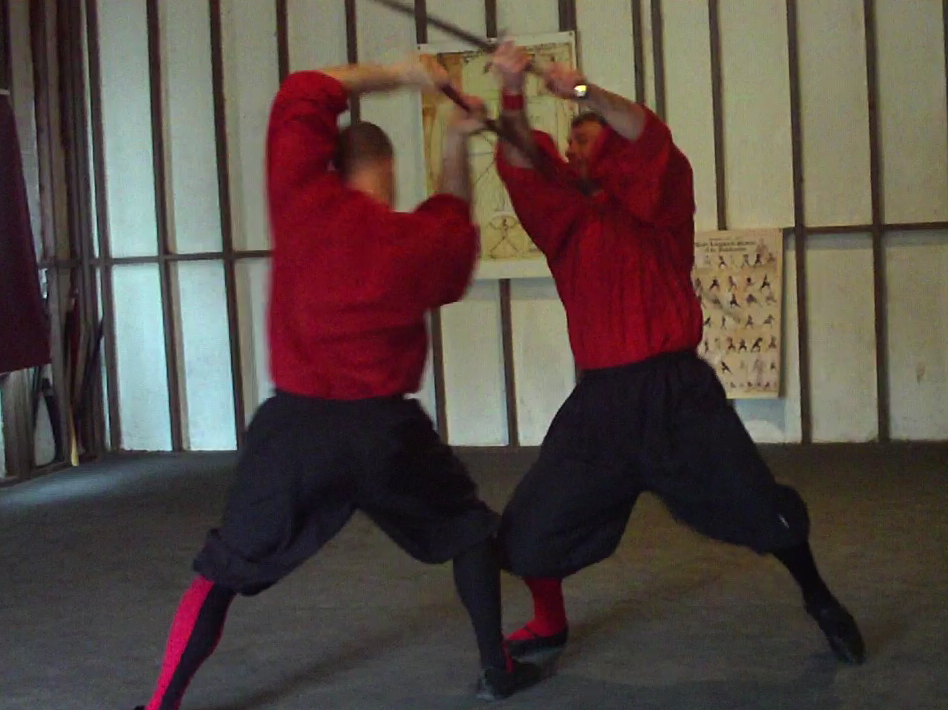 This
is a testament to how little is presently understood about authentic Renaissance
swordplay and how far there still is to go in reviving the craft. While
a comparison can be made between most any types of historical swords,
this specific question likely comes up because most people are more familiar
with a conception of historical European swordplay through the collegiate/Olympic
version of fencing game. In light of the ignorance many modern fencers
hold about Renaissance era swords and sword combat, honest attempts to
offer contrast and comparison can frequently take the form of criticism.
The effort here a will be in addressing the question as an academic exercise. This
is a testament to how little is presently understood about authentic Renaissance
swordplay and how far there still is to go in reviving the craft. While
a comparison can be made between most any types of historical swords,
this specific question likely comes up because most people are more familiar
with a conception of historical European swordplay through the collegiate/Olympic
version of fencing game. In light of the ignorance many modern fencers
hold about Renaissance era swords and sword combat, honest attempts to
offer contrast and comparison can frequently take the form of criticism.
The effort here a will be in addressing the question as an academic exercise.
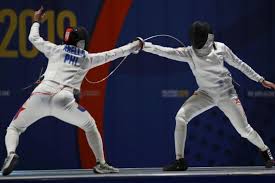 Despite
the universal elements of timing, range, and perception (of both leverage
and action) that underlie all styles of fencing, there are at least ten
major reasons why the longsword differs so much from modern fencing’s
foil, épée, and sabre. The disparity revealed in this contrast underscores
their considerable dissimilarity. Spotlighting these differences I believe
can go a long way toward helping understand the place of Renaissance martial
arts study today. Despite
the universal elements of timing, range, and perception (of both leverage
and action) that underlie all styles of fencing, there are at least ten
major reasons why the longsword differs so much from modern fencing’s
foil, épée, and sabre. The disparity revealed in this contrast underscores
their considerable dissimilarity. Spotlighting these differences I believe
can go a long way toward helping understand the place of Renaissance martial
arts study today.
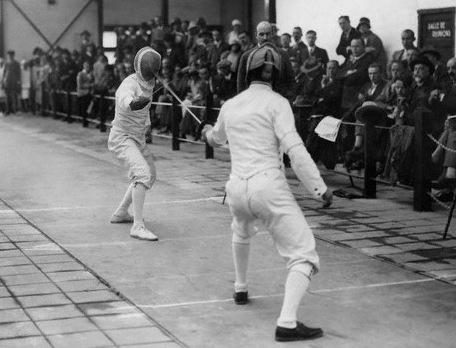 There
is no question that when exposed to the authentic methods and techniques
of the longsword people are very often surprised at how unique its actions
are. Its distinct manner of use is then easily discerned in comparison
to what they know from modern fencing, regularly witness from choreographed
scenes in popular entertainment, or experience in familiar displays of
stunt fencing. Any sound attempt to address this topic must therefore
begin with one incontestable fact: modern
fencing includes no equivalent system of fighting to that of the longsword
--- a weapon that is arguably the foundational tool of Renaissance martial
arts. There
is no question that when exposed to the authentic methods and techniques
of the longsword people are very often surprised at how unique its actions
are. Its distinct manner of use is then easily discerned in comparison
to what they know from modern fencing, regularly witness from choreographed
scenes in popular entertainment, or experience in familiar displays of
stunt fencing. Any sound attempt to address this topic must therefore
begin with one incontestable fact: modern
fencing includes no equivalent system of fighting to that of the longsword
--- a weapon that is arguably the foundational tool of Renaissance martial
arts.
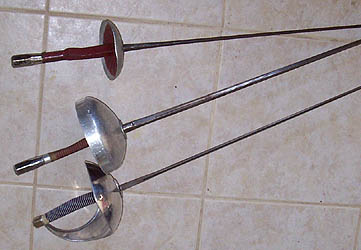 Setting
aside factors of associated exercise and drill, what can we note of the
major differences between the practice of the late Medieval and early
Renaissance longsword compared with that for the tools of modern fencing?
In the first instance we are referring to what is now known of the martial
practice of essentially German and Italian warswords of the 14th to 16th
centuries. In the second case we are referring to the post-Renaissance
style of Baroque foil, epee, and sabre dueling sports refined in the 19th
century and formalized in the early 20th. Each of these sword groups and
their individual manner of use developed under particular military and
civilian self-defense environments, with their own particular social and
cultural components. Without intending any value judgments, in one instance
we have a weapon of war that, in several forms, was intended for self-defense
in battle and judicial combat. On the other side we have versions of swords
designed strictly for unarmored fighting that are now pseudo-weapons devised
exclusively for a sport of gentlemanly mock-duel. Neither group
of swords was ever employed against the other historically (or competitively).
They are separated by centuries of change in military technology and self-defence
needs. Setting
aside factors of associated exercise and drill, what can we note of the
major differences between the practice of the late Medieval and early
Renaissance longsword compared with that for the tools of modern fencing?
In the first instance we are referring to what is now known of the martial
practice of essentially German and Italian warswords of the 14th to 16th
centuries. In the second case we are referring to the post-Renaissance
style of Baroque foil, epee, and sabre dueling sports refined in the 19th
century and formalized in the early 20th. Each of these sword groups and
their individual manner of use developed under particular military and
civilian self-defense environments, with their own particular social and
cultural components. Without intending any value judgments, in one instance
we have a weapon of war that, in several forms, was intended for self-defense
in battle and judicial combat. On the other side we have versions of swords
designed strictly for unarmored fighting that are now pseudo-weapons devised
exclusively for a sport of gentlemanly mock-duel. Neither group
of swords was ever employed against the other historically (or competitively).
They are separated by centuries of change in military technology and self-defence
needs.
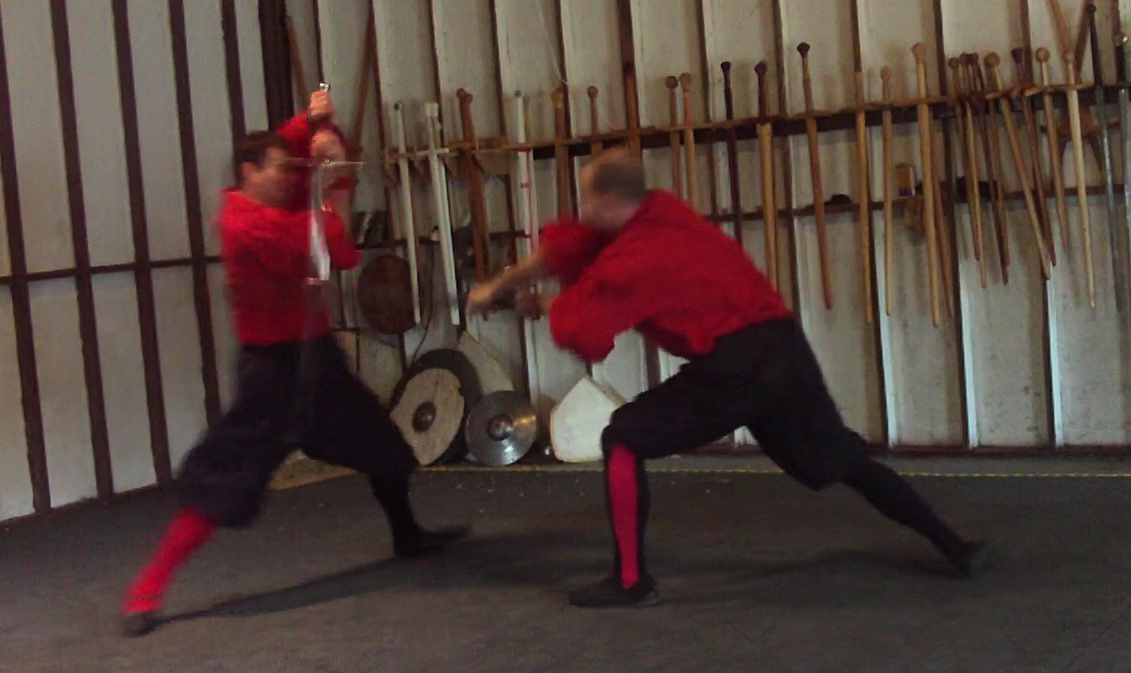 To
best understand the technical and methodological differences between these
fencing styles some context is necessary. It is no difficulty to understand
that the military and social changes that occurred over the generations
influenced designs of swords and affected occasions for sword combat.
Longswords, by necessity, faced polearms, shields, two-weapon combinations,
daggers, hard and soft armors, in group and individual encounters.
A prerequisite of this time was the ability to both cut and thrust forcibly
as well as grapple effectively, whether armored or unarmored, mounted
or on foot. In the face of substantially different war technologies, by
the 18th and 19th centuries military swordplay deteriorated considerably
and atrophied into near vestigial forms from that of past ages. At the
same time the sword declined in its battlefield utility, fencing styles
became focused more on aristocratic duels of honors emphasizing the mere
drawing of blood over the delivery of lethal killing blows in instances
of general self-defense. To
best understand the technical and methodological differences between these
fencing styles some context is necessary. It is no difficulty to understand
that the military and social changes that occurred over the generations
influenced designs of swords and affected occasions for sword combat.
Longswords, by necessity, faced polearms, shields, two-weapon combinations,
daggers, hard and soft armors, in group and individual encounters.
A prerequisite of this time was the ability to both cut and thrust forcibly
as well as grapple effectively, whether armored or unarmored, mounted
or on foot. In the face of substantially different war technologies, by
the 18th and 19th centuries military swordplay deteriorated considerably
and atrophied into near vestigial forms from that of past ages. At the
same time the sword declined in its battlefield utility, fencing styles
became focused more on aristocratic duels of honors emphasizing the mere
drawing of blood over the delivery of lethal killing blows in instances
of general self-defense.
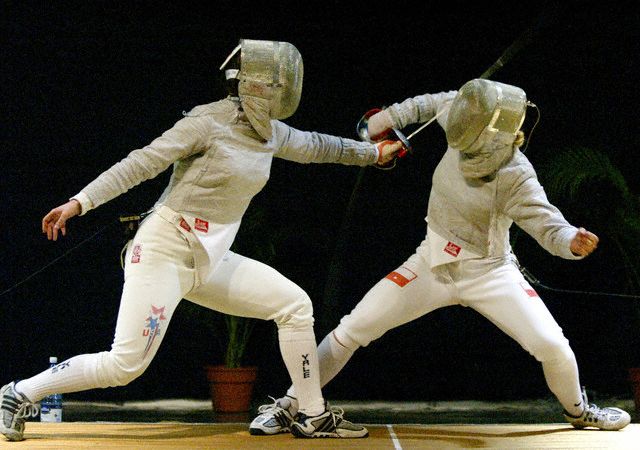 As
greatswords, two-handed swords, and bastard-swords, the long double-handed
European sword varied from wide parallel-edged blades suited to powerful
cleaving blows, to acutely tapering ones intended for thrusting at stronger
armors. Their design was never uniform but varied only within certain
limits and their blades came in several cross-sectional geometries that
might be flanged or squared. Their hilts might be of a simple cruciform
design with long handle or any manner of elaborately ringed bars and contracting
grip. (Some version of longswords were even single-edged with clipped
points) In their variety they were much like their single-hand cousins,
the common arming sword. But regardless of their form or geographic
region of use, over centuries longswords followed a closely similar method
of use (the singular styles of immense two-handed great-swords of the
16th century not being in consideration here). Study of the longsword
was historically accomplished by swordsmen working with “sharps,”
using wooden practice versions, and relying on special blunt training
blades. As
greatswords, two-handed swords, and bastard-swords, the long double-handed
European sword varied from wide parallel-edged blades suited to powerful
cleaving blows, to acutely tapering ones intended for thrusting at stronger
armors. Their design was never uniform but varied only within certain
limits and their blades came in several cross-sectional geometries that
might be flanged or squared. Their hilts might be of a simple cruciform
design with long handle or any manner of elaborately ringed bars and contracting
grip. (Some version of longswords were even single-edged with clipped
points) In their variety they were much like their single-hand cousins,
the common arming sword. But regardless of their form or geographic
region of use, over centuries longswords followed a closely similar method
of use (the singular styles of immense two-handed great-swords of the
16th century not being in consideration here). Study of the longsword
was historically accomplished by swordsmen working with “sharps,”
using wooden practice versions, and relying on special blunt training
blades.
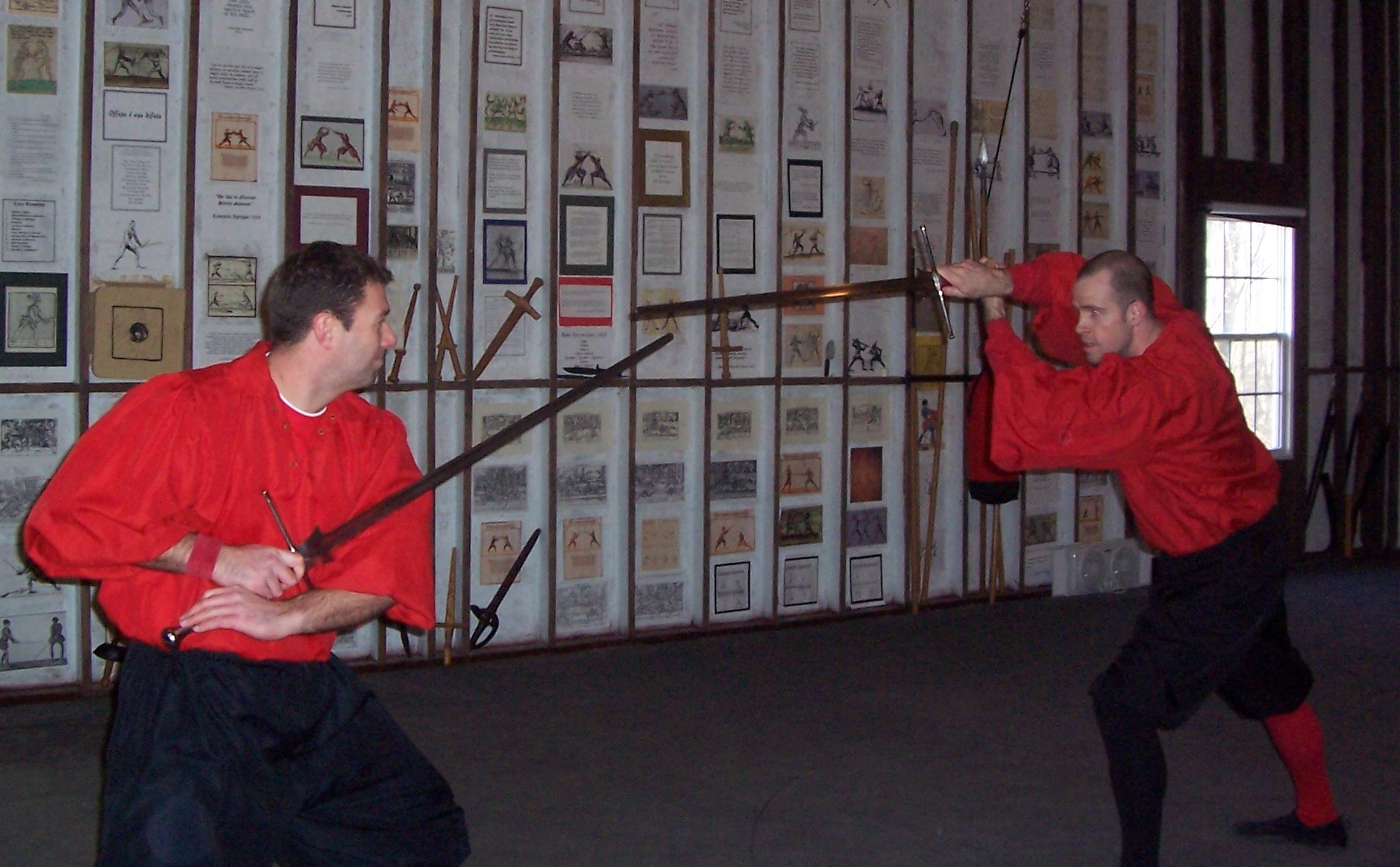
In
contrast, the three current tools of modern fencing (foil, epee, and saber)
have for more than a century existed almost exclusively as sporting versions
--- mock-weapons almost incapable of lethal injury. Their highly flexible
featherweight forms (two descended from the later rapier or smallsword
and the third from a type of light dueling broadsword or cutlass) are
far removed from their historical counterparts. They were intentionally
devised for scoring safe points in a mock duelling game and serve for
all aspects of practice. They were never real swords used for any actual
close-combat self-defense. Their system is based exclusively on a regulated
single-combat encounter against the same identical weapon. Their limited
style of play is restricted to formal actions that at times reward what
would otherwise be suicidal to attempt in life or death fights. Even if
given sharp points these tools would be difficult to be put into lethal
use under open conditions. It is these distinctions that then bring
us to the major ways they differ.
Ten Central Reasons
Here then are ten fundamental reasons I offer
for why longsword fencing differs so much form modern fencing:
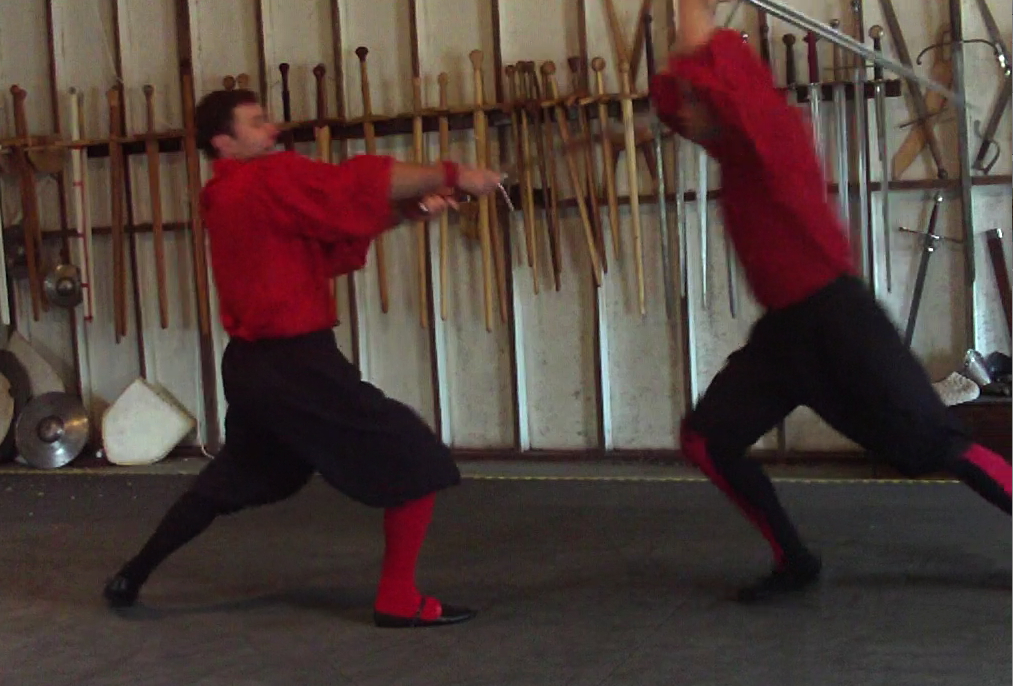 1. Two-handed Actions: By its nature, using two-hands on
a weapon obviously permits (and encourages) more powerful blows that can
be instantly deadly. Using two hands on a longer weapon also teaches the
fencer almost instinctively to use greater body leverage. This in turn
cultivates finding different leverage points against an opposing two-handed
weapon than those occurring with a single-handed weapon (especially a
slender foyning---thrusting---sword). But beyond this, double-handed control
of a weapon affects the way in which it can be torqued around, and thus,
the range of symmetrical motions that are permissible. This further influences
the ideal form of stances, manners of stepping, and the diversity of fighting
actions. Far more so than with actions performed with one arm (or the
mere fingers of a single hand), the whole body and the full arm becomes
involved to nimbly wield the weapon symmetrically with proper strength.
Correspondingly, the fencer immediately learns to deal with the onslaught
of forceful cuts and thrusts deliverable with two-hands on any nearly
kind of weapon. Of course, even when training with two-hands on a longer
sword the fencer still learns to effectively use the weapon in one hand
when necessary. Permitting only one hand on a sword---any kind of sword---eliminates
a whole dimension of possible application, as well as the best way to
defend against such action.
1. Two-handed Actions: By its nature, using two-hands on
a weapon obviously permits (and encourages) more powerful blows that can
be instantly deadly. Using two hands on a longer weapon also teaches the
fencer almost instinctively to use greater body leverage. This in turn
cultivates finding different leverage points against an opposing two-handed
weapon than those occurring with a single-handed weapon (especially a
slender foyning---thrusting---sword). But beyond this, double-handed control
of a weapon affects the way in which it can be torqued around, and thus,
the range of symmetrical motions that are permissible. This further influences
the ideal form of stances, manners of stepping, and the diversity of fighting
actions. Far more so than with actions performed with one arm (or the
mere fingers of a single hand), the whole body and the full arm becomes
involved to nimbly wield the weapon symmetrically with proper strength.
Correspondingly, the fencer immediately learns to deal with the onslaught
of forceful cuts and thrusts deliverable with two-hands on any nearly
kind of weapon. Of course, even when training with two-hands on a longer
sword the fencer still learns to effectively use the weapon in one hand
when necessary. Permitting only one hand on a sword---any kind of sword---eliminates
a whole dimension of possible application, as well as the best way to
defend against such action.
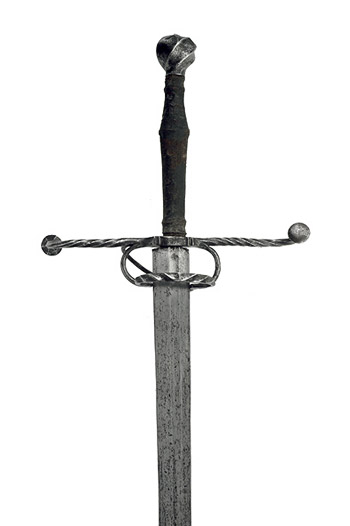
2. Two-Edge Striking: Most straight two-handed sword blades were
double-edged. Though this may seem obvious, it is a crucial element in
fencing. The significance of this has been horrendously overlooked among
modern sword enthusiasts and arms historians. Two edges permit twice
as many cuts as a single edge. This goes far beyond mere chopping and
hacking. With a long double-hand sword, especially, many cuts are performed
with the back of the sword (the
“short” edge). It multiplies the strikes possible as well
as alters the way leverage and other actions can be employed. This
allows a more versatile combination of techniques to be rapidly delivered.
With the longsword either edge may be used symmetrically for any action. There are no similar two-edge actions in modern fencing. With the exception of minor actions by the short false edge on the back the sabre all
cuts are performed with the forward leading edge. There are no true
doube-edge strikes possible with it given its assymetrical manner of
gripping, while the foil and epee do not use any cuts in any form
whatsoever. This removes another whole dimension of
application. (There are also no “slicing actions” in modern
fencing whereby an edge is pressed forcibly against a target to produce
a slashing wound.)
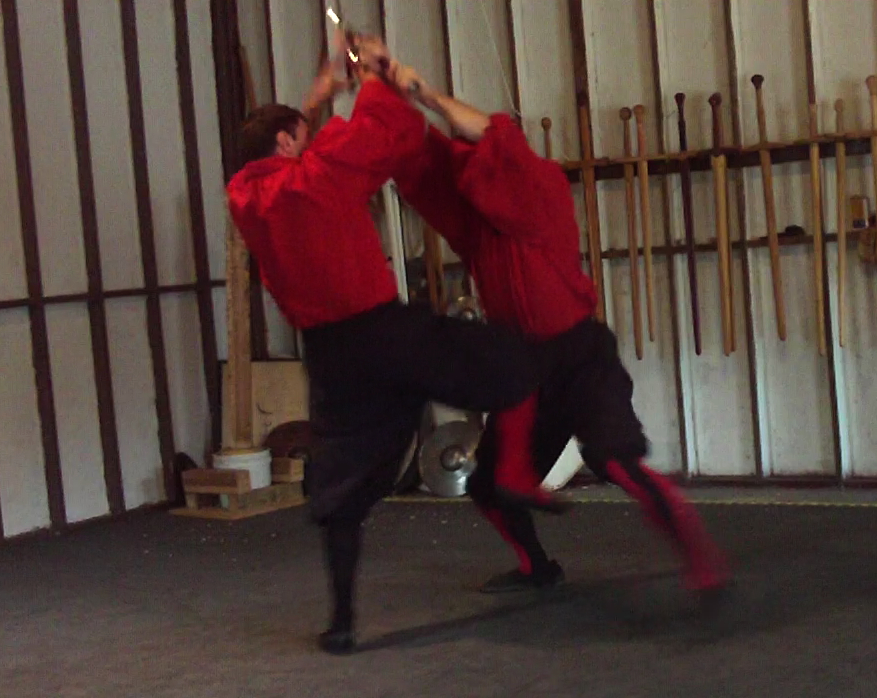 3.
Use of the Second Hand: Another obvious element of fencing
with a longsword is that because two hands are used, either hand is employed
as needed. This means that as the primary-hand grips the weapon the second
hand may let go to thereby knock aside threats, strike blows with the
palm or fist, grip the opponent or seize his weapon. Aside from interfering
with their freedom of action or even disarming them, the whole arm may
be employed in this way to gain a leverage advantage. Such offensive and
defensive techniques are integral and intrinsic to Medieval and Renaissance
close combat in general. Made with quick and coordinated motions they
lead to a diverse and sophisticated repertoire of grappling and disarming
moves that make up a considerable component of overall martial prowess.
It is impossible to understand Renaissance fencing without skillful use
of the second hand in this way. (To do otherwise would be akin to attempting
to box with one hand against a boxer using two.) Modern fencing,
by contrast, does not permit any contact of the second hand with the weapon
or the body of either combatant.
The reasoning for this has nothing to do with combat effective swordsmanship.
It instead reflects the later etiquette that grabbing and slapping at
weapons, seizing one another’s garments, and striking with the empty
hand was unseemly for a gentleman’s duel or “civilized”
sport. Though lost to later fencing styles and long misunderstood, actions
with the free-hand are especially germane to the longsword. 3.
Use of the Second Hand: Another obvious element of fencing
with a longsword is that because two hands are used, either hand is employed
as needed. This means that as the primary-hand grips the weapon the second
hand may let go to thereby knock aside threats, strike blows with the
palm or fist, grip the opponent or seize his weapon. Aside from interfering
with their freedom of action or even disarming them, the whole arm may
be employed in this way to gain a leverage advantage. Such offensive and
defensive techniques are integral and intrinsic to Medieval and Renaissance
close combat in general. Made with quick and coordinated motions they
lead to a diverse and sophisticated repertoire of grappling and disarming
moves that make up a considerable component of overall martial prowess.
It is impossible to understand Renaissance fencing without skillful use
of the second hand in this way. (To do otherwise would be akin to attempting
to box with one hand against a boxer using two.) Modern fencing,
by contrast, does not permit any contact of the second hand with the weapon
or the body of either combatant.
The reasoning for this has nothing to do with combat effective swordsmanship.
It instead reflects the later etiquette that grabbing and slapping at
weapons, seizing one another’s garments, and striking with the empty
hand was unseemly for a gentleman’s duel or “civilized”
sport. Though lost to later fencing styles and long misunderstood, actions
with the free-hand are especially germane to the longsword.
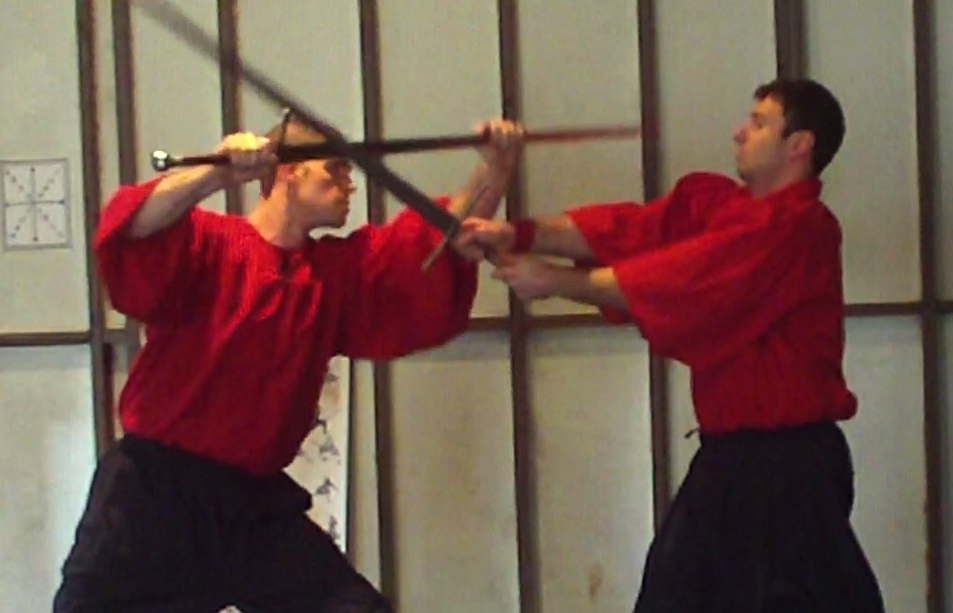 4. Half-Swording: As a weapon, the longsword was never
just held by the handle (as is so ubiquitous in modern depictions of historical
sword combat within popular media and games.) A
common technique with most all Medieval and Renaissance swords was that
of “half-swording” --- the grasping of almost any portion
of the blade with one or even both hands. Whether for a wide or a tapering
blade, a considerable portion of longsword technique in both armored and
unarmored fighting consisted of this. Blades were gripped in such a way
as to prevent the palm or fingers being sliced open. In this manner
the sword could be instantly shortened for quick forceful thrusts, ward
with greater coverage, and held for increased leverage when close in.
Managed in such a way the longsword could be easily manipulated as if
it were a short staff to press, hit, and trap with either end as well
as with the point. It could also be wielded as if it were a spear, a warhammer,
or a polaxe, striking (or defending) with the pommel or cross. Quickly
transitioning back and forth between such actions provided for a powerful
and fluid form of fencing that permitted a dynamic use of leverage. There
is no equivalent to half-swording in modern fencing, wherein for reasons
of etiquette and sportsmanship participants are forbidden in anyway from
touching either their own blade or that of their opponent.
4. Half-Swording: As a weapon, the longsword was never
just held by the handle (as is so ubiquitous in modern depictions of historical
sword combat within popular media and games.) A
common technique with most all Medieval and Renaissance swords was that
of “half-swording” --- the grasping of almost any portion
of the blade with one or even both hands. Whether for a wide or a tapering
blade, a considerable portion of longsword technique in both armored and
unarmored fighting consisted of this. Blades were gripped in such a way
as to prevent the palm or fingers being sliced open. In this manner
the sword could be instantly shortened for quick forceful thrusts, ward
with greater coverage, and held for increased leverage when close in.
Managed in such a way the longsword could be easily manipulated as if
it were a short staff to press, hit, and trap with either end as well
as with the point. It could also be wielded as if it were a spear, a warhammer,
or a polaxe, striking (or defending) with the pommel or cross. Quickly
transitioning back and forth between such actions provided for a powerful
and fluid form of fencing that permitted a dynamic use of leverage. There
is no equivalent to half-swording in modern fencing, wherein for reasons
of etiquette and sportsmanship participants are forbidden in anyway from
touching either their own blade or that of their opponent.
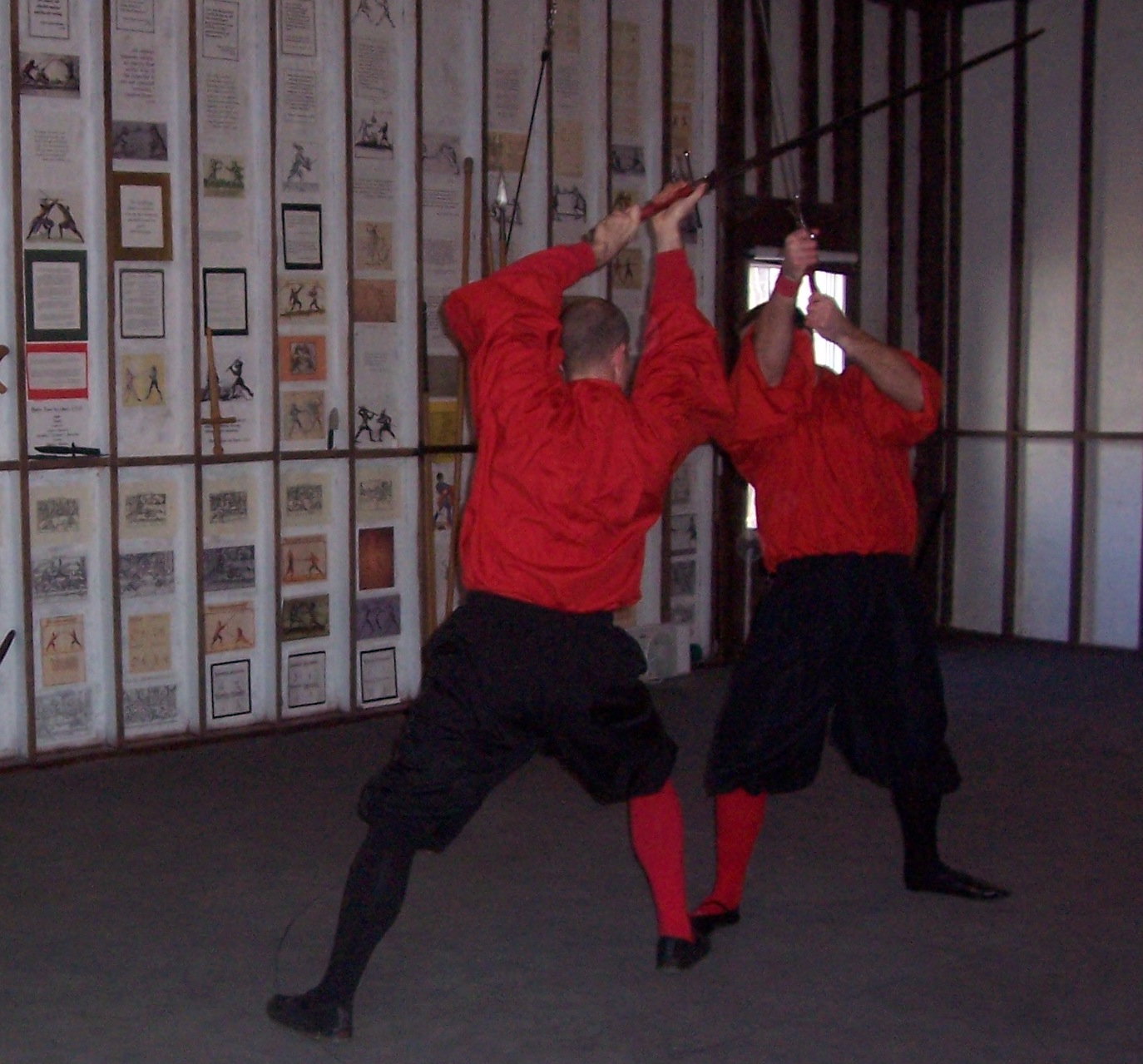
5. Displacing of Strikes: The historical source teachings on the
longsword are unanimous that defensive actions are best accomplished by
offensive actions. They recommend
the optimal defense as bring a single-time action---a counter-strike that
displaces (or breaks) the oncoming cut or thrust. What is most difficult
for modern fencers and sword enthusiasts to grasp is the concept of defense
found throughout Renaissance fighting literature: simultaneously delivering
a strike while in the same motion closing-in to stifle an attack by encountering
the opponent’s weapon near its hilt using your blade near its hilt.
This action takes into account the force of the strikes that must be opposed
as well as the understanding that closing against an attacker is frequently
an ideal option. Where counter-striking a blow is not always possible,
warding off or setting aside a cut (by receiving it on the flat of the
blade, not the edge) is then proscribed. However, passively catching oncoming
strikes with a rigid block (common practice in modern fencing) was never
advised. 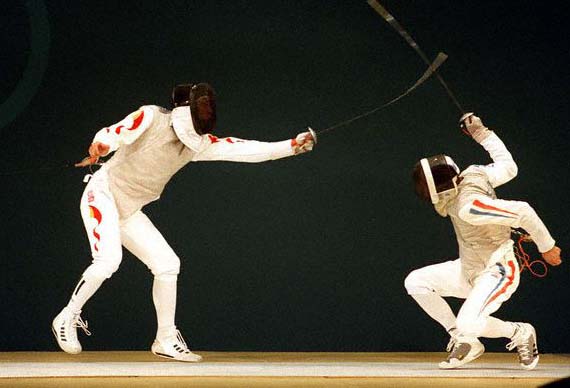 This
is the opposite of the simpler “parry-riposte” theory of swordplay that
dominates so many forms of fencing now. Statically taking a blow edge
on edge, as became standard operating procedure throughout the
post-Renaissance broadsword and cutlass play of the 18th and 19th
centuries, was simply not taught. Modern fencing, by comparison, relies
almost solely on this “double-time” defense with a separate intentional
parrying action (derived from the Baroque smallsword, and even deemed a
progressive idea). With the modern fencing sabre, whose blade is a mere
thin vestigial rod, any portion of the edge may even suffice for
blocking cuts. Counter-cuts that displace, whether by meeting hilt to
hilt or by striking to the flat of the opponent’s blade, are entirely
unknown except for those minor ones that can naturally occur with
body motion. The profound change in dynamic that occurs between fencing
concerned not with static blocking but with counter-striking and
closing in to prevent the opponent’s freedom of action cannot be
emphasized enough. This
is the opposite of the simpler “parry-riposte” theory of swordplay that
dominates so many forms of fencing now. Statically taking a blow edge
on edge, as became standard operating procedure throughout the
post-Renaissance broadsword and cutlass play of the 18th and 19th
centuries, was simply not taught. Modern fencing, by comparison, relies
almost solely on this “double-time” defense with a separate intentional
parrying action (derived from the Baroque smallsword, and even deemed a
progressive idea). With the modern fencing sabre, whose blade is a mere
thin vestigial rod, any portion of the edge may even suffice for
blocking cuts. Counter-cuts that displace, whether by meeting hilt to
hilt or by striking to the flat of the opponent’s blade, are entirely
unknown except for those minor ones that can naturally occur with
body motion. The profound change in dynamic that occurs between fencing
concerned not with static blocking but with counter-striking and
closing in to prevent the opponent’s freedom of action cannot be
emphasized enough.
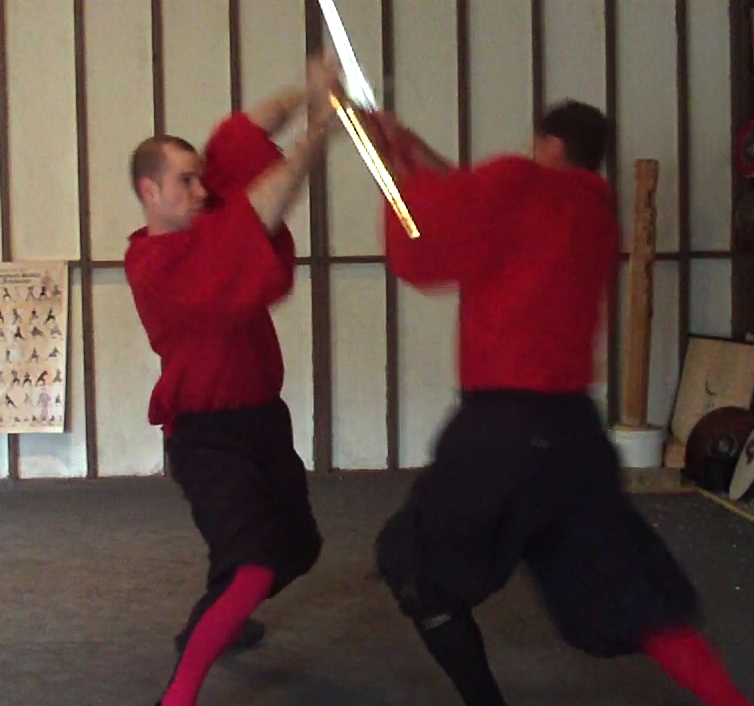
6. Binding and Winding: The willingness to aggressively enter in
to bind and wind against the opponent’s weapon was a chief characteristic
of close-combat in the Medieval and Renaissance eras. The longsword
did not utilize the deliberately restrained parry and riposte so common
in modern depictions of swordfights and illusory swordplay found in popular
entertainment. Instead, the longsword’s length and inertia were
utilized to actively intercept against and around the opponent’s
wards, striking to their openings or forcing their defense, the whole
time gaging their pressure and controlling leverage blade on blade. All
the while, every opportunity was taken to exploit the entire inventory
of actions available to a swordsman---forcibly delivering cuts, thrusts,
and slices with either edge as well as freely entering in close to use
the hilt, grip the blade, and use the second hand. The physical attributes
of the longsword and the context of its fighting was not focused on simply
gaining range and timing while feinting back and forth in rapid linear
attack and parry exchanges without body-to-body contact, as conducted
in fencing now. Rather, binding and winding requires intentionally
seeking close contact with the opponent’s weapon and/or body.
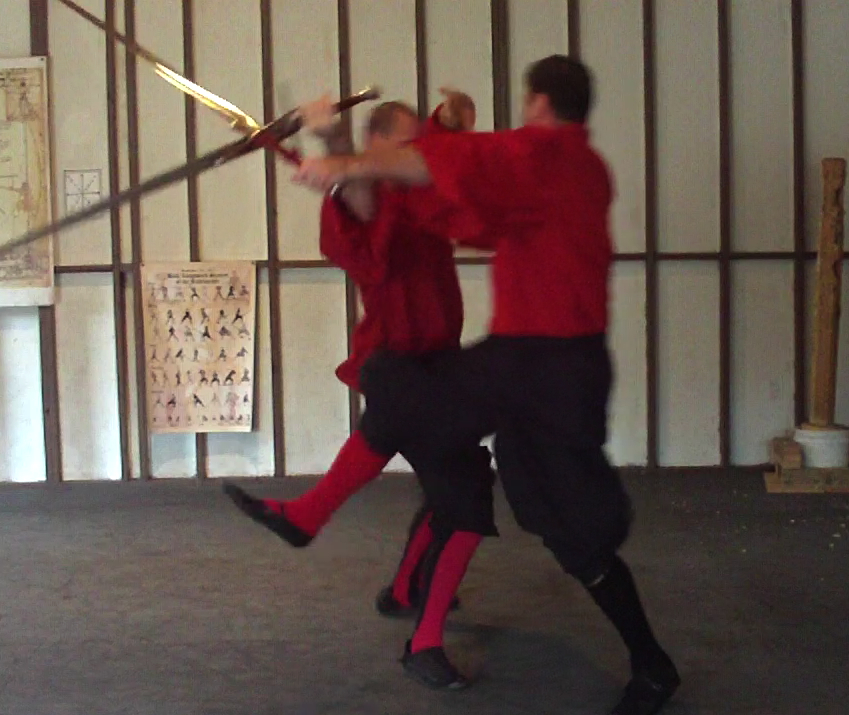 7.
Full-Body Action: Full-body action in striking at targets and affecting
balance is crucial to all aspects of a fighting art, whether armed or
unarmed. In practicing the longsword it is assumed that blows are to be
delivered in a lethal manner. Although, it is recognized that due to the
quality of strikes, the location of wounds, and differences in physiology
and temperate among fighters, not all blows are always immediately debilitating
or incapacitating. It is also understood that though blows are to be performed
with full speed and force (practiced as if for lethal intent), for reasons
of practical safety in training this is not possible at all times.
Nonetheless, there is constant awareness in the longsword fencer of the
opponent’s entire anatomy as a valid target and cognizance of what
techniques to what locations will produce lethal results. No part of the
body is ignored as an invalid target or one that a blow can be received
upon without serious consequence. Additionally, an inherent appreciation
is developed for how the head-to-toe workings of key joints and muscles
relate to leveraging the opponent’s balance at all points of contact.
A longsword fencer must always act with purposeful consideration for the
mutual use of forceful body contact to gain leverage. To strike with necessary
force, the longsword fencer employs passing, traversing, turning, leading
with either leg, forceful arm and leg motions, and maintaining a lower
stance. The longsword fencer cannot allow his leg to be swept out from
under him, his foot or thigh to be stomped on, his knee, groin, or stomach
to be kicked, his face struck by a hilt or hand, or his arm and weapon
to be grabbed. None of these elements are a concern whatsoever in fencing
with the foil, epee, or sabre, where any hit is as good as any other and
no awareness of body-to-body leverage (or body to weapon leverage) is
cultivated. In modern fencing blade-on-blade play is the exclusive focus
of all action. 7.
Full-Body Action: Full-body action in striking at targets and affecting
balance is crucial to all aspects of a fighting art, whether armed or
unarmed. In practicing the longsword it is assumed that blows are to be
delivered in a lethal manner. Although, it is recognized that due to the
quality of strikes, the location of wounds, and differences in physiology
and temperate among fighters, not all blows are always immediately debilitating
or incapacitating. It is also understood that though blows are to be performed
with full speed and force (practiced as if for lethal intent), for reasons
of practical safety in training this is not possible at all times.
Nonetheless, there is constant awareness in the longsword fencer of the
opponent’s entire anatomy as a valid target and cognizance of what
techniques to what locations will produce lethal results. No part of the
body is ignored as an invalid target or one that a blow can be received
upon without serious consequence. Additionally, an inherent appreciation
is developed for how the head-to-toe workings of key joints and muscles
relate to leveraging the opponent’s balance at all points of contact.
A longsword fencer must always act with purposeful consideration for the
mutual use of forceful body contact to gain leverage. To strike with necessary
force, the longsword fencer employs passing, traversing, turning, leading
with either leg, forceful arm and leg motions, and maintaining a lower
stance. The longsword fencer cannot allow his leg to be swept out from
under him, his foot or thigh to be stomped on, his knee, groin, or stomach
to be kicked, his face struck by a hilt or hand, or his arm and weapon
to be grabbed. None of these elements are a concern whatsoever in fencing
with the foil, epee, or sabre, where any hit is as good as any other and
no awareness of body-to-body leverage (or body to weapon leverage) is
cultivated. In modern fencing blade-on-blade play is the exclusive focus
of all action.
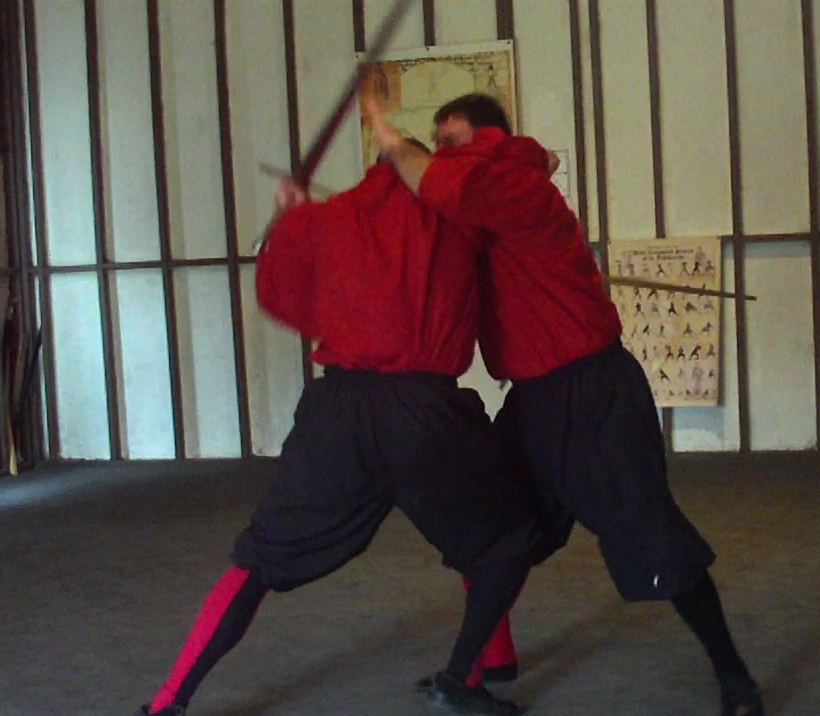 8. Grappling: That grappling (wrestling or unarmed moves) was long
an integral component of fencing skills is indisputable. Body contact
involving leveraging with both hands and even the weapon itself is an
important aspect of armed combat that cannot be separated from the reality
of Medieval and Renaissance swordplay. At the closest range disarms, throws,
take downs, kicks, hand blows, and seizing and trapping, are employed
in conjunction with whatever sword or hand weapon a fighter has. These
actions were removed from later fencing only as aristocratic gentlemen
came to consider grabbing at one another, tearing at clothing, or franticly
clutching at each other’s weapons to be uncouth and ill-suited to
a refined activity of mannered deportment. To “hit and not be hit”
does not mean to never touch the other person’s body or weapon in
the process. Holding and seizing, pushing and pulling, leveraging with
arm, knee, leg, and foot are neither primitive nor crude. To employ them
safely and effectively demands considerable fencing skills on the part
of the swordsman. Excluding them is not an “improvement” of
fencing skill but a narrowing de-evolution. Indeed, fencing is at its
most expert when these things augment and extend the utility of a sword.
But modern fencing does not involve coming to the ground at any
time. The fencers at no time ever learn to fall or to make someone else
fall.
8. Grappling: That grappling (wrestling or unarmed moves) was long
an integral component of fencing skills is indisputable. Body contact
involving leveraging with both hands and even the weapon itself is an
important aspect of armed combat that cannot be separated from the reality
of Medieval and Renaissance swordplay. At the closest range disarms, throws,
take downs, kicks, hand blows, and seizing and trapping, are employed
in conjunction with whatever sword or hand weapon a fighter has. These
actions were removed from later fencing only as aristocratic gentlemen
came to consider grabbing at one another, tearing at clothing, or franticly
clutching at each other’s weapons to be uncouth and ill-suited to
a refined activity of mannered deportment. To “hit and not be hit”
does not mean to never touch the other person’s body or weapon in
the process. Holding and seizing, pushing and pulling, leveraging with
arm, knee, leg, and foot are neither primitive nor crude. To employ them
safely and effectively demands considerable fencing skills on the part
of the swordsman. Excluding them is not an “improvement” of
fencing skill but a narrowing de-evolution. Indeed, fencing is at its
most expert when these things augment and extend the utility of a sword.
But modern fencing does not involve coming to the ground at any
time. The fencers at no time ever learn to fall or to make someone else
fall.
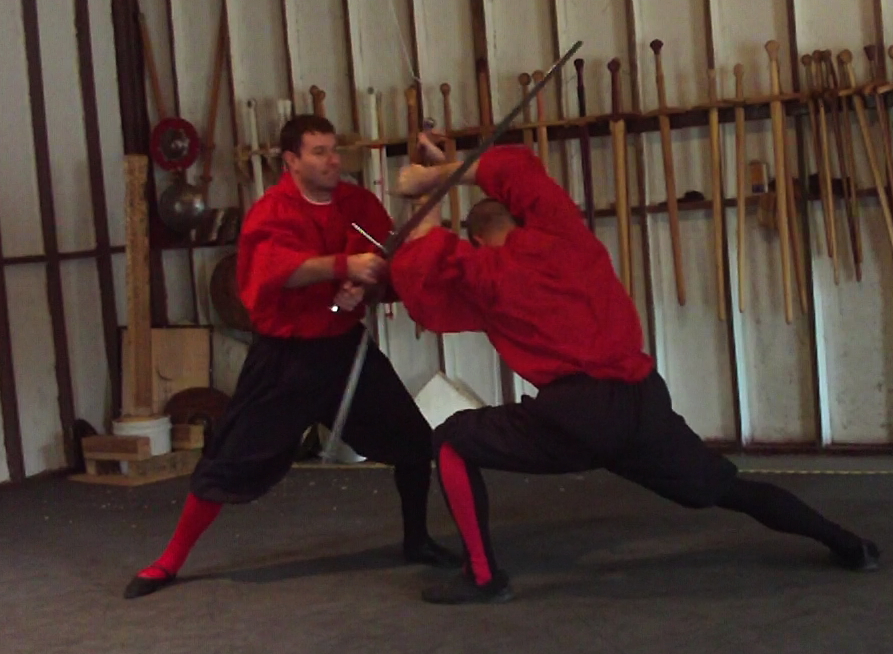 9. Hilt and Gripping: The composition of the hilt on a longsword
(typically a simple cross-guard or cruciform shape) is a direct factor
of how the weapon is used. The longsword’s hilt was employed as
much for offensive as for defensive actions. Its function is more sophisticated
than has been commonly presented in choreographed fight scenes and stunt
fighting performances. The longsword’s hilt is in no way inferior
or less developed than the compound bars and cups attached to later swords.
Additionally, such hilts sometimes had side rings and sloped bars, which
facilitated in actively catching and guarding against other blades and
hilts. Further, there are also several versatile manners of gripping a
longsword that permit different actions or allow various techniques. These
may involve the placement of the thumb on the cross bar or the flat of
the blade, wrapping the index finger around the cross, grasping the pommel
in the palm, shifting the grip toward the center of the handle, shifting
the weapon to one hand, or holding the weapon by the blade itself. The
blade may even have flanges (small protruding spikes) above its cross
that assist in binding, winding, and trapping. None of these central
elements is known or of any significance with the style used for modern
fencing.
9. Hilt and Gripping: The composition of the hilt on a longsword
(typically a simple cross-guard or cruciform shape) is a direct factor
of how the weapon is used. The longsword’s hilt was employed as
much for offensive as for defensive actions. Its function is more sophisticated
than has been commonly presented in choreographed fight scenes and stunt
fighting performances. The longsword’s hilt is in no way inferior
or less developed than the compound bars and cups attached to later swords.
Additionally, such hilts sometimes had side rings and sloped bars, which
facilitated in actively catching and guarding against other blades and
hilts. Further, there are also several versatile manners of gripping a
longsword that permit different actions or allow various techniques. These
may involve the placement of the thumb on the cross bar or the flat of
the blade, wrapping the index finger around the cross, grasping the pommel
in the palm, shifting the grip toward the center of the handle, shifting
the weapon to one hand, or holding the weapon by the blade itself. The
blade may even have flanges (small protruding spikes) above its cross
that assist in binding, winding, and trapping. None of these central
elements is known or of any significance with the style used for modern
fencing.
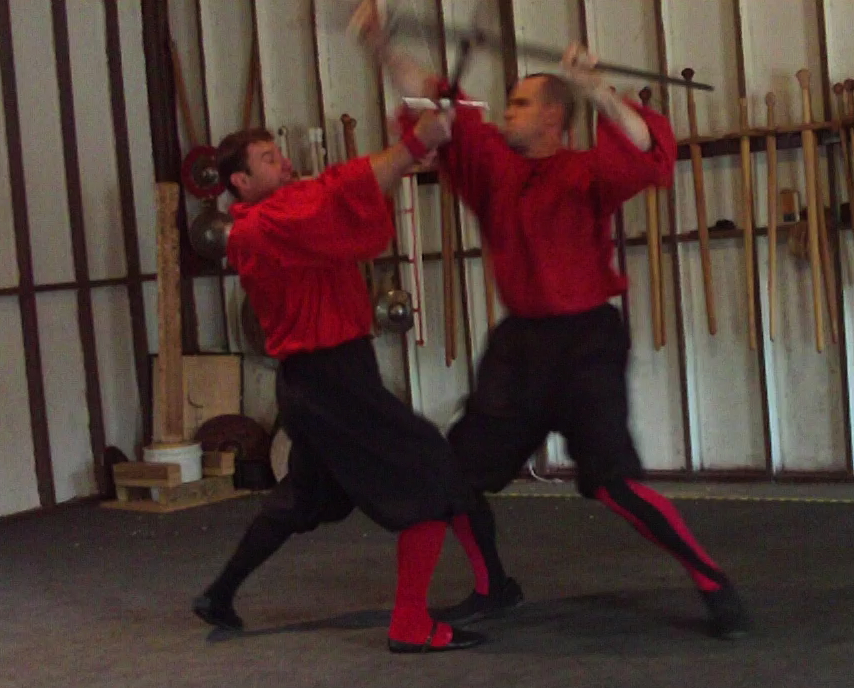 10. Weight of the Weapon: Longswords were never usually more than
3 or 4 pounds. This was a factor of the need at the time to “use
force” and “strike strongly” in close combat. The longsword’s
size and mass would seem the most obvious area of difference between it
and the tools of modern fencing. Yet, this is easily the least noteworthy
consideration. Whether for the tapering thinner form of blade (i.e., a
spadone or espée
bastardo) or the wider parallel-edged design (a warsword or espée
du guerre), the longsword was required to face other diverse weapons
and armors, and even multiple opponents. It was expected to find use under
any conditions and on any ground, not merely encounter an identical copy
of itself in unarmored single combat. The weapon’s weight therefore
gives it a distinctly different sense of maneuverability and force, compelling
transitions from warding to cut and thrust as well as crossing to close
in. This is in turn obliges different stances than the linear L-shaped
one of modern fencing.
10. Weight of the Weapon: Longswords were never usually more than
3 or 4 pounds. This was a factor of the need at the time to “use
force” and “strike strongly” in close combat. The longsword’s
size and mass would seem the most obvious area of difference between it
and the tools of modern fencing. Yet, this is easily the least noteworthy
consideration. Whether for the tapering thinner form of blade (i.e., a
spadone or espée
bastardo) or the wider parallel-edged design (a warsword or espée
du guerre), the longsword was required to face other diverse weapons
and armors, and even multiple opponents. It was expected to find use under
any conditions and on any ground, not merely encounter an identical copy
of itself in unarmored single combat. The weapon’s weight therefore
gives it a distinctly different sense of maneuverability and force, compelling
transitions from warding to cut and thrust as well as crossing to close
in. This is in turn obliges different stances than the linear L-shaped
one of modern fencing. 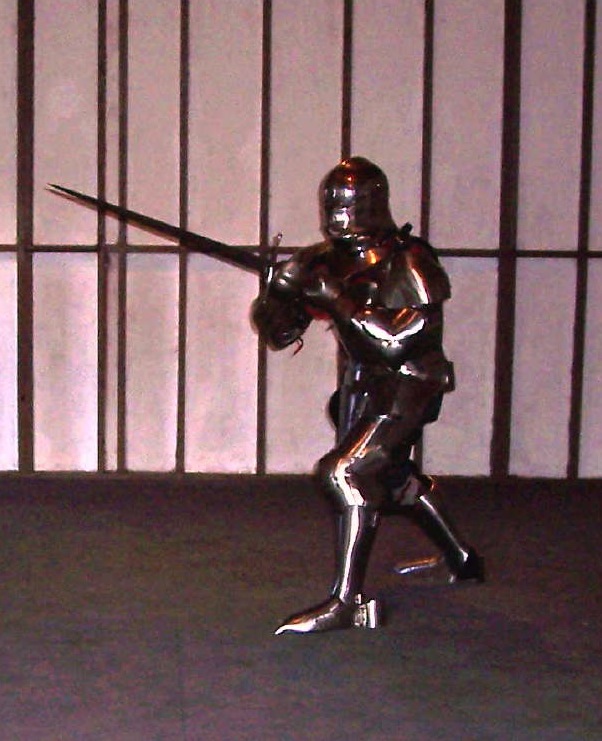 Contrary
to many modern misrepresentations, longsword footwork hardly employed
the same identical stepping and lunging of the modern style. As an athletic
craft of disciplined violence, the deadly force required in earnest encounters
with such robust weapons demanded training to strike with speed, accuracy,
and deception. All actions are optimized for incapacitating and debilitating
impacts. At no time does a longsword fencer contemplate executing a suicidal
attack because they will score a hit a millisecond sooner than their opponent.
Rather, if at any time an adversary is considered still capable of continued
lethal resistance, then the fight has hardly ended. The longsword fencer
does not drop his guard because he knows he has made an effective hit
under a set of rules. It is always assumed a mortally wounded opponent
is still entirely capable of striking back. In modern fencing, however,
once having made a valid hit on the opponent, with a flexible weapon weighing
mere ounces, no effort is made to immediately avoid being struck afterward
by an otherwise lethal blow. Such blows are simply ignored. Contrary
to many modern misrepresentations, longsword footwork hardly employed
the same identical stepping and lunging of the modern style. As an athletic
craft of disciplined violence, the deadly force required in earnest encounters
with such robust weapons demanded training to strike with speed, accuracy,
and deception. All actions are optimized for incapacitating and debilitating
impacts. At no time does a longsword fencer contemplate executing a suicidal
attack because they will score a hit a millisecond sooner than their opponent.
Rather, if at any time an adversary is considered still capable of continued
lethal resistance, then the fight has hardly ended. The longsword fencer
does not drop his guard because he knows he has made an effective hit
under a set of rules. It is always assumed a mortally wounded opponent
is still entirely capable of striking back. In modern fencing, however,
once having made a valid hit on the opponent, with a flexible weapon weighing
mere ounces, no effort is made to immediately avoid being struck afterward
by an otherwise lethal blow. Such blows are simply ignored.
Contrast in Consideration
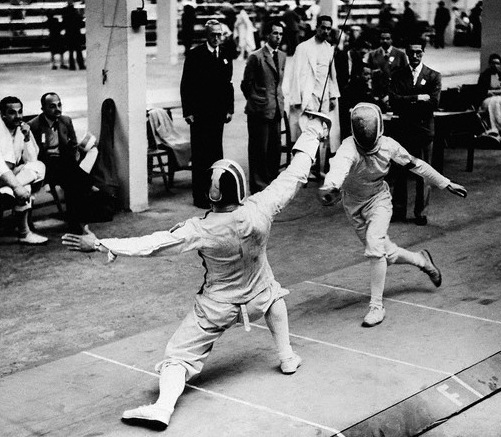 The
ten points described here combine to reveal something that may serve to
summarize the fundamental underlying difference at work: The nature of
longsword fencing is about the practice of fighting
skills---the study of a martial art. This is self-apparent but
it bears clarification. As in the study of other Medieval and Renaissance
weaponry, bouting (or free-play) with the longsword is conducted not as
an end in itself but for purposes of developing skill in the craft. As
opposed to skill being directed toward a game of scoring points in a mock
duel, a large repertoire of the actions in fencing with the longsword
consists of techniques which are actually too dangerous or too brutal
to safely use in mock combat, but nonetheless must be trained in and prepared
for. The
ten points described here combine to reveal something that may serve to
summarize the fundamental underlying difference at work: The nature of
longsword fencing is about the practice of fighting
skills---the study of a martial art. This is self-apparent but
it bears clarification. As in the study of other Medieval and Renaissance
weaponry, bouting (or free-play) with the longsword is conducted not as
an end in itself but for purposes of developing skill in the craft. As
opposed to skill being directed toward a game of scoring points in a mock
duel, a large repertoire of the actions in fencing with the longsword
consists of techniques which are actually too dangerous or too brutal
to safely use in mock combat, but nonetheless must be trained in and prepared
for.
The
significance of this distinction, in terms of both the mindset and application
of fighting discipline, cannot be understated. It directly affects how
a student of the subject approaches its study today. It also shatters
the assertion that post-Baroque fencing can serve as a basis for modern
study of the longsword. Just as a you would not want to try to fence
with the method of the longsword using the weapons of modern fencing,
neither would you want to try to wield a longsword with the style of the
foil, epee, or saber (though, many have tried and some shamefully still
do).
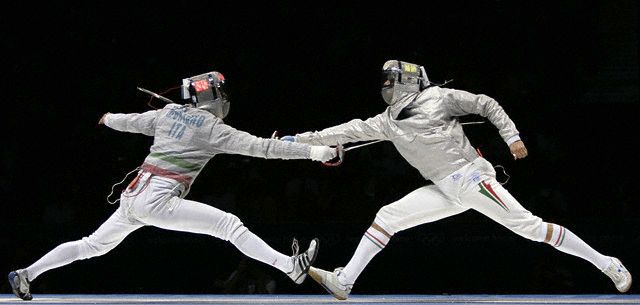 The
comparison here, then, essentially comes down to comparing a respected
sport with a recovered martial art --- that is, a tactical and athletic
competitive game on one hand with a close-combat system for a weapon of
war and single-combat on the other. As ideally pursued today, the method
employed with the longsword is taken from the direct historical source
teachings of Masters of Defense from an era for which the weapon was readily
employed in all manner of brutal and savage close-combat. The fencing
style of the modern sport, by contrast, largely descends from those contrived
for gentlemanly duels, developed in an age unmolested by the challenges
of diverse arms and armors on and off the battlefield. This was then modified
into an artificial game. Whereas the longsword is currently undergoing
its own reconstruction process of interpretation and revival, modern fencing
has already undergone a considerable process of “de-martialization”
(i.e., ritualization, civilianization, and sportification). The
comparison here, then, essentially comes down to comparing a respected
sport with a recovered martial art --- that is, a tactical and athletic
competitive game on one hand with a close-combat system for a weapon of
war and single-combat on the other. As ideally pursued today, the method
employed with the longsword is taken from the direct historical source
teachings of Masters of Defense from an era for which the weapon was readily
employed in all manner of brutal and savage close-combat. The fencing
style of the modern sport, by contrast, largely descends from those contrived
for gentlemanly duels, developed in an age unmolested by the challenges
of diverse arms and armors on and off the battlefield. This was then modified
into an artificial game. Whereas the longsword is currently undergoing
its own reconstruction process of interpretation and revival, modern fencing
has already undergone a considerable process of “de-martialization”
(i.e., ritualization, civilianization, and sportification).
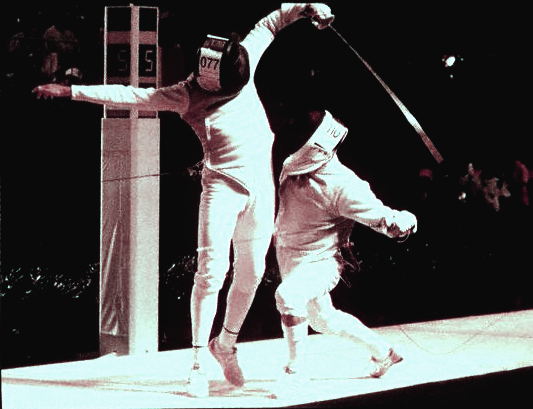 These
significant differences help explain why the longsword has in modern times
been poorly considered and almost wholly misunderstood, and thus also
why its lost art remained for so long unrealized and un-recovered by modern
era fencing masters and sword enthusiasts. With no one who retained
its teachings, and few who were attempting to credibly pursue it as a
true martial art along in appropriate manner, it is no wonder its distinction
from modern sporting styles has been so little understood. These
significant differences help explain why the longsword has in modern times
been poorly considered and almost wholly misunderstood, and thus also
why its lost art remained for so long unrealized and un-recovered by modern
era fencing masters and sword enthusiasts. With no one who retained
its teachings, and few who were attempting to credibly pursue it as a
true martial art along in appropriate manner, it is no wonder its distinction
from modern sporting styles has been so little understood.
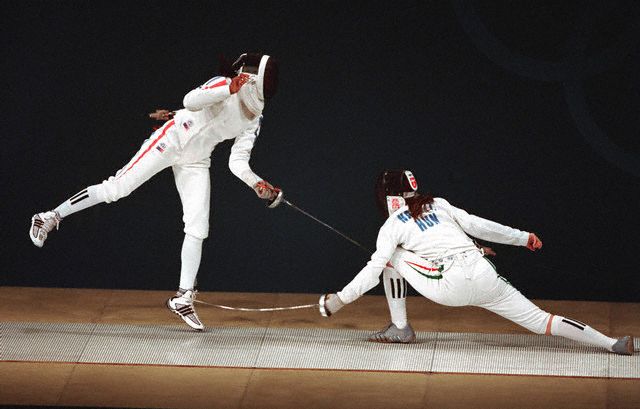 While
the fencing of foil, epee, and sabre have been well-established as casual
combat sports for more than a century now, to be legitimately studied
again today the rich but entirely forgotten tradition of the European
longsword must be approached from the perspective of its historical practice---as
a true martial art, not a recreational game. This fact is all the
more obvious when we fully realize the incontestable differences between
the two. (This certainty also renders more clearly the reasons why modern
fencers have long failed to reproduce the lost teachings of Renaissance
combatives.) While
the fencing of foil, epee, and sabre have been well-established as casual
combat sports for more than a century now, to be legitimately studied
again today the rich but entirely forgotten tradition of the European
longsword must be approached from the perspective of its historical practice---as
a true martial art, not a recreational game. This fact is all the
more obvious when we fully realize the incontestable differences between
the two. (This certainty also renders more clearly the reasons why modern
fencers have long failed to reproduce the lost teachings of Renaissance
combatives.)
Modern
styles of fencing originate from those developed during the
Enlightenment and the Age of Reason, in which defending aristocratic
honor and the punctilios of gentlemanly etiquette were the larger concern.
The longsword, by contrast, is a product of a Medieval and Renaissance
warrior ethos. They each are the product of two very different fencing
cultures. This is reflected in the significant difference by which both
are practiced.
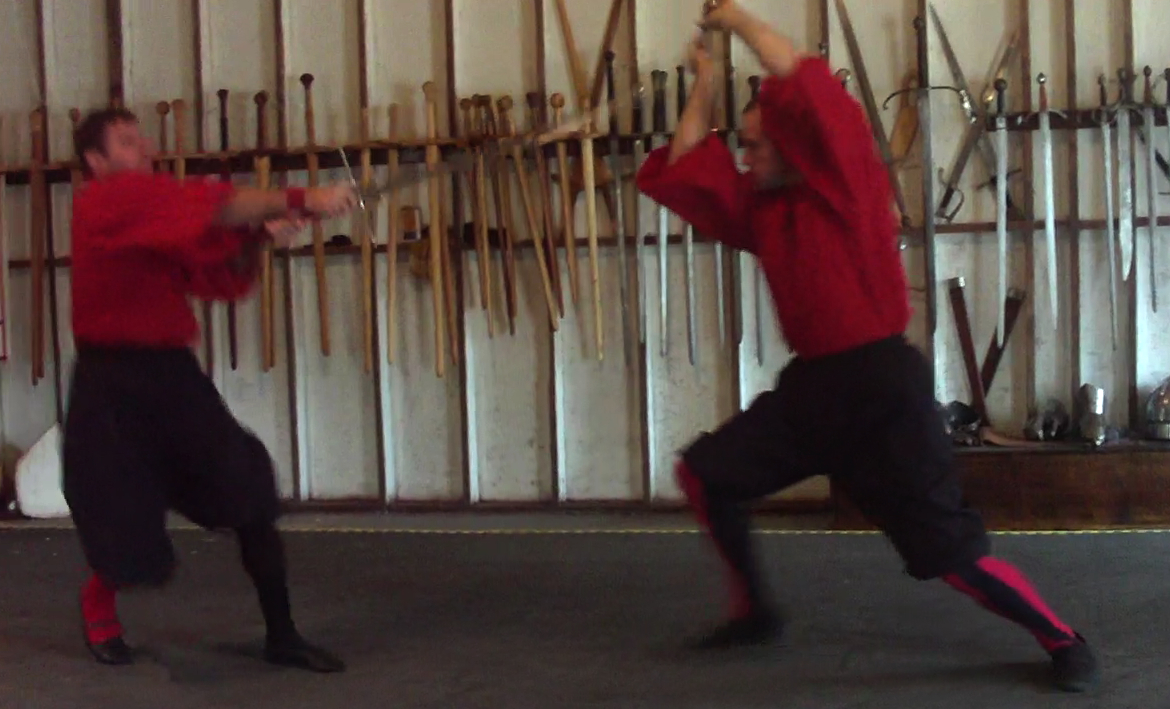 While
modern fencing’s conceptualized gentlemanly duel is a great competitive
sport and athletic game with its own respectable lineage, it
is not a martial art. It is a version of mock-dueling far removed
from its far more sophisticated Renaissance ancestors. While the specialization
of fencing actions down into just a handful of possibilities necessary
to score a point with flexible practice-weapons in a safe sport can seem
like an evolutionary refinement, it is rather an attempt to control the
chaos of close combat by minimizing it into a game that can be prescribed
rules and boundaries. To elide in this way makes sense when reducing techniques
to the specialized needs of a martial sport or the narrow context of a
ritualized combat. While
modern fencing’s conceptualized gentlemanly duel is a great competitive
sport and athletic game with its own respectable lineage, it
is not a martial art. It is a version of mock-dueling far removed
from its far more sophisticated Renaissance ancestors. While the specialization
of fencing actions down into just a handful of possibilities necessary
to score a point with flexible practice-weapons in a safe sport can seem
like an evolutionary refinement, it is rather an attempt to control the
chaos of close combat by minimizing it into a game that can be prescribed
rules and boundaries. To elide in this way makes sense when reducing techniques
to the specialized needs of a martial sport or the narrow context of a
ritualized combat.
But
the commensurate loss of self-defense knowledge that then takes place
is the very antithesis of the martial skill required in a broader combat
system. It is only because the
craft of the longsword has only recently been reconstructed with any accuracy
(entirely outside of the community of modern fencing, we must note) that
these differences of form (and bio-mechanics) can now be clarified.
Such then is the difference between the sport of modern fencing and the
historical martial art of the longsword. Understanding this context will
permit practitioners of either craft to better appreciate the place of
the other in the modern world.
See
also:
The
Centrality of the Longsword in Renaissance Martial Arts Study
January
2009
|

